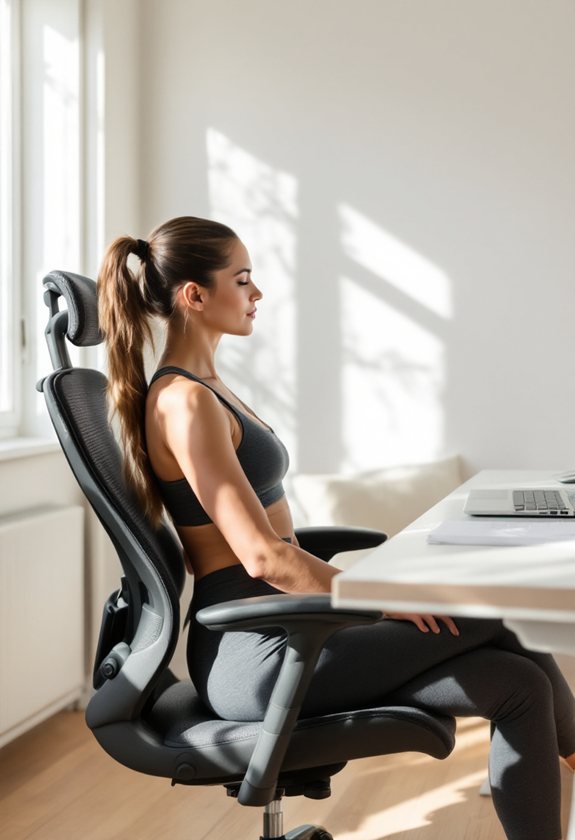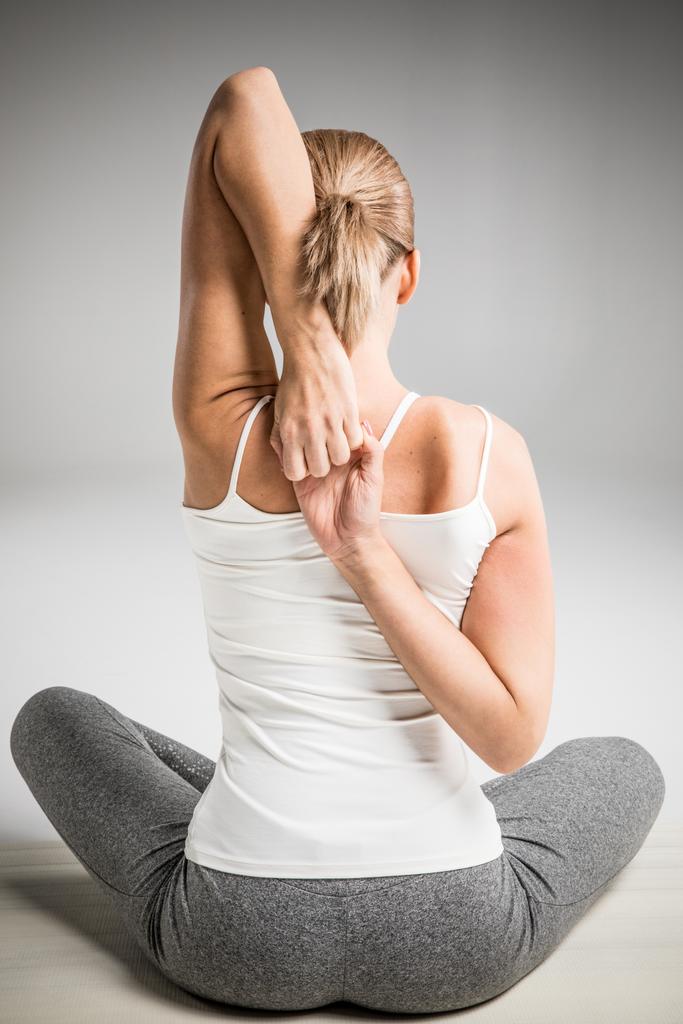You can energize your workday with seven simple desk chair yoga poses that combat fatigue and tension. Start with the Seated Cat-Cow to improve spinal alignment, then release shoulder tightness with Eagle Arms. Try Chair Pigeon Pose for hip flexibility, Side Stretches for core awakening, and Desk Forward Fold for back relief. Add Seated Spinal Twists and Upward Dog to complete your desk-based wellness routine. Uncover how these gentle movements can transform your entire workday.
Key Takeaways
- Seated Cat-Cow increases energy levels through synchronized breathing and gentle spinal movements, improving overall posture and alertness.
- Eagle Arms releases shoulder tension and enhances blood flow through arm crossing, making you feel instantly refreshed.
- Chair Pigeon Pose stimulates energy by releasing hip tightness and emotional tension while improving lower body circulation.
- Side Stretches awaken the body's core strength and increase oxygen flow through lateral movements and deep breathing.
- Desk Forward Fold reduces mental fatigue and boosts energy by releasing tension in the back, neck, and shoulders.
The Seated Cat-Cow: A Spine-Saving Solution
While you might feel stuck at your desk all day, there's a simple yoga pose that can help transform your workspace into a mini wellness sanctuary.
The Seated Cat-Cow pose combines gentle movement with breathing techniques to improve spinal alignment and reduce tension in your back.
Synchronizing breath with fluid spinal movements, this seated yoga pose offers a way to release tension and restore natural alignment.
To perform this pose safely, sit tall in your chair with feet flat on the floor and hands on knees. As you inhale, arch your back and lift your chest, creating the "cow" position.
Then exhale, rounding your spine and tucking your chin for the "cat" position. Practice this flowing movement 5-10 times to release stress and energize your body.
Eagle Arms: Release Your Shoulder Tension
If you've ever felt the weight of stress mounting in your shoulders after hours of computer work, the Eagle Arms pose can offer sweet relief. This tension-busting pose improves shoulder mobility while delivering comfort right at your desk.
| Benefits | How to Do It |
|---|---|
| Instant tension relief | Cross arms, right under left |
| Better posture | Press palms together if possible |
| Improved flexibility | Hold and breathe deeply |
You'll love how this pose fits seamlessly into your workday. Simply sit tall, wrap your arms, and breathe deeply. Remember to switch sides for balanced shoulder mobility, and you'll notice the difference in how your upper body feels.
Chair Pigeon Pose for Hip Relief
Tight hips are just as common as shoulder tension when you're sitting at your desk all day.
The Chair Pigeon Pose offers a gentle way to improve hip flexibility while releasing emotional tension stored in your hip area.
To practice safely, start by sitting tall in your chair with both feet flat on the floor.
Cross your right ankle over your left thigh, keeping your foot flexed to protect your knee.
As you breathe deeply, gently press down on your right knee to deepen the stretch.
Hold for 3-5 breaths, then switch sides.
You'll feel a soothing release in your hips and glutes.
Side Stretches to Awaken Your Core
Long hours at your desk can leave you feeling stiff and disconnected from your core strength.
Side stretches offer powerful lateral extension benefits that'll wake up your torso while releasing tension in your ribcage and spine. You'll find immediate relief as you gently lean to each side.
To enhance core engagement techniques, start by sitting tall in your chair with both feet flat on the floor.
Lift your right arm overhead, and slowly lean to the left, feeling the stretch along your side body. Hold for three breaths, then switch sides.
You'll notice improved breathing and energy as you practice regularly.
The Desk Forward Fold for Back Health
When your back feels tense from sitting at your desk, a gentle forward fold can provide immediate relief and therapeutic benefits for your spine.
As you practice this pose, you'll notice desk forward fold benefits like reduced stress, improved digestion, and increased flexibility in your hamstrings and lower back.
For safe practice, start with desk yoga modifications that work for your body. Keep your feet flat on the floor while seated, and slowly hinge forward from your hips.
If you're feeling stiff, rest your hands on your thighs rather than reaching for the floor. Remember to breathe deeply and release any tension in your neck and shoulders.
Seated Spinal Twists for Better Posture
If you've been feeling stiff and uncomfortable at your desk, seated spinal twists can transform your workday posture and comfort level.
These gentle twist variations help maintain proper spinal alignment while relieving tension in your back, shoulders, and neck.
Simple spinal twists can restore alignment and ease tension throughout your upper body, helping you move and feel better.
To practice safely, start by sitting tall in your chair with both feet flat on the floor.
Place your right hand on the chair's armrest or back, and your left hand on your right knee.
As you exhale, slowly twist to the right, keeping your spine lengthened.
Hold for 3-5 breaths, then switch sides.
Remember to maintain a straight spine and never force the twist.
Upward Dog at Your Desk: Energy Boost
Transform your desk into an energizing yoga space with the upward dog pose, a powerful stretch that'll wake up your whole body.
When you're feeling sluggish at work, this pose offers incredible desk benefits, from improved posture to reduced shoulder tension.
- Place your hands shoulder-width apart on your desk
- Step back, keeping arms straight but not locked
- Lift your chest while drawing shoulders down
- Engage your core as you breathe deeply
Remember to distribute your weight evenly and keep your core engaged to protect your lower back.
You'll feel energized and refreshed, ready to tackle your next task with renewed focus.
Frequently Asked Questions
Can I Practice Desk Chair Yoga if I Have Chronic Joint Pain?
You can safely practice chair yoga with chronic joint pain. It's an effective chronic pain management tool that improves joint flexibility, but consult your healthcare provider before starting.
What Should I Wear When Doing Desk Chair Yoga at Work?
Wear comfortable clothing that's office-appropriate and made from breathable fabrics. Choose loose-fitting pants or skirts with stretchy tops that won't restrict your movement during gentle stretches at your desk.
How Long Should I Hold Each Desk Yoga Pose?
Hold each pose for 15-60 seconds while taking 4-8 deep breaths. You'll want to adjust your pose duration and stretching frequency based on your comfort level and flexibility.
Will Desk Chair Yoga Exercises Disturb My Coworkers?
You won't disturb coworkers if you follow proper office etiquette. Most chair yoga poses are quiet and discreet, and you can practice during breaks to maintain coworker comfort.
Can Desk Yoga Help With Carpal Tunnel Syndrome Symptoms?
Yes, you'll find relief from carpal tunnel symptoms through gentle yoga stretches. Practice wrist relief exercises carefully, focusing on flexibility and circulation while avoiding positions that cause discomfort.
Conclusion
You're now equipped with simple yet powerful desk yoga poses that you can practice anytime during your workday. By incorporating these stretches into your daily routine, you'll help prevent stiffness, enhance your energy levels, and improve your general wellbeing. Remember, even a few minutes of mindful movement can make a significant difference in how you feel. Start with what's comfortable, and let these poses become your natural workplace wellness allies.



